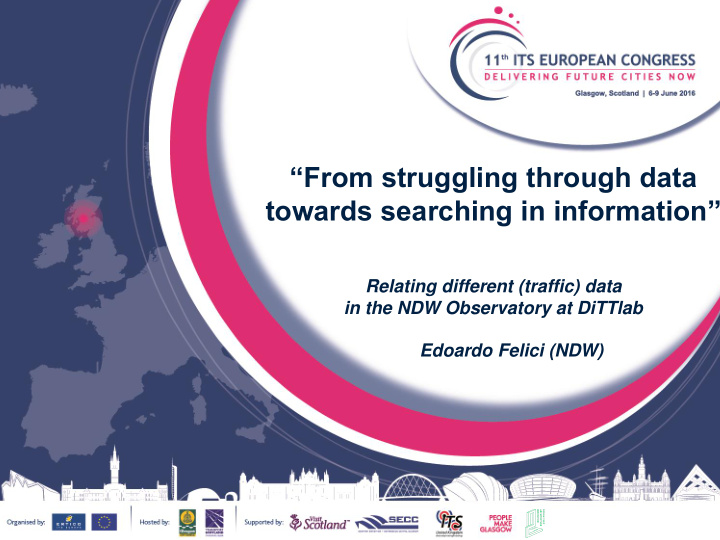



“From struggling through data towards searching in information” Relating different (traffic) data in the NDW Observatory at DiTTlab Edoardo Felici (NDW)
NDW: a unique alliance of 19 authorities
Traffic information Up-to-date, complete and unambiguous
Traffic management Central source for all road authorities
Traffic policy and traffic research
Goals • Less traffic jams • Safer roads • Less emissions
Happy road users
DiTTlab scope (Real-time) diagnostics, estimation & prediction (Open-source) Evaluation & Multiscale Simulation assessment (BIG) Data Virtual Reality, Processing Gaming Mixed Reality
Overall DiTTlab architecture H - Visualisers, analysers, • An integrated framework exporters • (Open) data from all E - OpenTrafficSim Ontology possible sources: A - OpenTraffic – Simulator Traffic G - GUI’s / Editors – Transport – Networks B - OpenTrafficSim Input & toolset (Calibratie, Validatie, Identificatie, Fusie, Assimilatie tools) • Advanced data assimiliation and analyses C - Database F - GIS • (dynamic data: traffic, Open source multi-scale, transport, weather, etc) (semi-static data: multi-modal traffic and transport infra & built environment) transport simulations D - data import
NDW project: an intelligent database • From struggling through data to searching through information Mild Roadside day fire April 28 2015 June 8 2015 Heavy Large rainfall accident March 24 2015 11 May 31 2015
Large accident March 24 2015 Large Large accident accident A20, June 9 2015 A16, January 9 2015
NDW-tool • Webtool to join and present different data Java / Javascript / leaflet types GetEvents GetASMStats GetWeather GetMeaspoints GetDailyEvents GetDailyTotals GetRWTotals GetCrossections GetDailyWeath Detectors er - multiple Netezza DB: measurement Dittlab.tudelft DB: • 2,382,489,886 lane/usrclass • 12447 Cross sections points records dynamic • 66589 measurement points Cross-section measurements (March (5,1M considering changes over 2015) time) • ca 1/10 of that roadway • ALL Geo functionality records dynamic data
Different congestion patterns with different causes
15
CLASS 1 CLASS 2 CLASS 3 16
Super fast searches in a mega database • Step 1 – train the database to recognize congestions patterns (Available) Metadata Clustered congestion graphs • from databases / GIS: Type X • Date and time • Route characteristics (geo & digraph info) • weather (rainy, 10 o Celsius, etc) Pictures: • Incidents / events • Don’t have to be the same size • Etc. • Type Y • Don’t need the same amount of pixels • Don’t need to have the same length-width ratio • Do need to have the same colormap To define/calculate • Do need the same time-space scale (to • Travel time loss detect shockwaves) • Travel time spread • Data quality • % freight • Demand patterns • Etc. • Type Z
Super fast searches in a mega database • Step 2 – Dissect the graphs in a “bag of features” (just like we do when recognizing faces) SURF algorithm Extract keypoints Feature descriptions Clustering of features K-means algorithm
Super fast searches in a mega database • Step 3 – Every traffic pattern can be summarized in a histogram of features (a vector with a number) Traffic pattern Feature vectors Class 1 Class 2 Class 3
Super fast searches in a mega database • Step 4 – Classification of new patterns So far so good … Dissection in “features” Unknown pattern TO-DO: iterative process (1) Start classification with limited data set (2) Manually refine classification (3) Retrain SVM classifier (4) Back to (1) Pattern type X Classification Training model
Super fast searches in a mega database This year: • Prototype of Co ngestion- S earch-eng I ne (CoSi) – Iterative refinement of the SVM classifier (until classification is accurate and precise enough) – Develop smart routines to find and classify all congestions patterns – Perform the classification – SVM + available metadata = Search-index • Refine and expand with weather- and other metadata • Build WebGUI for CoSi
That could go better!
DiTTlab next steps: how do we get data? Just like CSI: data fusion gives more, better and more robust evidence (1+1=3) Field measurements Examples of extra context: Real behaviour? • Circumstances (CAN Lab measurements data, weather, incidents, events, news, etc) • Network state & alternatives (ITS, parking, Public transport data) • OD, route- and modal split (GSM, Apps, public transport) • Driving experience, skill and style (Apps, CAN data) • Travel motives (social media, apps)
DiTTlab next steps: a different way of working! Just like CSI: data fusion gives more, better and 1. Many more (GIS-, mathematic-, modelling-) more robust evidence toolsets and skills needed (1+1=3) 2. Working in interdisciplinary teams Examples of extra context: • Circumstances (CAN ➡ Traffic engineers data, weather, incidents, ➡ Data scientists events, news, etc) • Network state & ➡ Computer scientists alternatives (ITS, parking, 3. Sharing data, sharing expertise (NL is too Public transport data) • OD, route- and modal small!) split (GSM, Apps, public transport) • Driving experience, skill and style (Apps, CAN data) • Travel motives (social media, apps)
Plans 2016 and beyond • Multi-scale estimation of all relevant variables • Based on NDW data and many other potential data sources (like bicycle data) • Estimation of main unknowns: • Volumes, vehicle loss hours • Inflows and turns (what comes on and what goes off) • Capacities, critical speeds • Network fundamental diagramme • Estimation of origin-destination information on different scale levels • Simulate (predict?) traffic based on available information on different scale levels
Multi-scale estimation of variables Dynamics 1 minute – few Dynamics 1-10 seconds Dynamics 5-30 minutes minutes Using CAM-bus, volumes Using CAM-bus, volumes on lanes, travel times, Using travel times, on lanes, travel times, local weather etc. volumes, travel times, origin-destinations, modal origin-destinations local split, regional weather weather etc. etc.
Hans van Lint Edoardo Felici j.w.c.vanlint@tudelft.nl edoardo.felici@ndw.nu
Recommend
More recommend